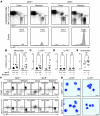Ly-6Chi monocytes dominate hypercholesterolemia-associated monocytosis and give rise to macrophages in atheromata
- PMID: 17200719
- PMCID: PMC1716211
- DOI: 10.1172/JCI29950
Ly-6Chi monocytes dominate hypercholesterolemia-associated monocytosis and give rise to macrophages in atheromata
Abstract
Macrophage accumulation participates decisively in the development and exacerbation of atherosclerosis. Circulating monocytes, the precursors of macrophages, display heterogeneity in mice and humans, but their relative contribution to atherogenesis remains unknown. We report here that the Ly-6C(hi) monocyte subset increased dramatically in hypercholesterolemic apoE-deficient mice consuming a high-fat diet, with the number of Ly-6C(hi) cells doubling in the blood every month. Ly-6C(hi) monocytes adhered to activated endothelium, infiltrated lesions, and became lesional macrophages. Hypercholesterolemia-associated monocytosis (HAM) developed from increased survival, continued cell proliferation, and impaired Ly-6C(hi) to Ly-6C(lo) conversion and subsided upon statin-induced cholesterol reduction. Conversely, the number of Ly-6C(lo) cells remained unaffected. Thus, we believe that Ly-6C(hi) monocytes represent a newly recognized component of the inflammatory response in experimental atherosclerosis.
Figures






Comment in
-
Macrophage heterogeneity and tissue lipids.J Clin Invest. 2007 Jan;117(1):89-93. doi: 10.1172/JCI30992. J Clin Invest. 2007. PMID: 17200712 Free PMC article.
References
-
- Hansson G.K., Libby P. The immune response in atherosclerosis: a double-edged sword. Nat. Rev. Immunol. 2006;6:508–519. - PubMed
-
- Libby P. Inflammation in atherosclerosis. Nature. 2002;420:868–874. - PubMed
-
- Ridker P.M., Hennekens C.H., Buring J.E., Rifai N. C-reactive protein and other markers of inflammation in the prediction of cardiovascular disease in women. N. Engl. J. Med. 2000;342:836–843. - PubMed
-
- Peter K., et al. Circulating vascular cell adhesion molecule-1 correlates with the extent of human atherosclerosis in contrast to circulating intercellular adhesion molecule-1, E-selectin, P-selectin, and thrombomodulin. Arterioscler. Thromb. Vasc. Biol. 1997;17:505–512. - PubMed
-
- Barron H.V., Cannon C.P., Murphy S.A., Braunwald E., Gibson C.M. Association between white blood cell count, epicardial blood flow, myocardial perfusion, and clinical outcomes in the setting of acute myocardial infarction: a thrombolysis in myocardial infarction 10 substudy. Circulation. 2000;102:2329–2334. - PubMed
Publication types
MeSH terms
Substances
Grants and funding
LinkOut - more resources
Full Text Sources
Other Literature Sources
Medical
Molecular Biology Databases
Miscellaneous

